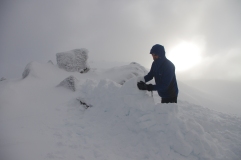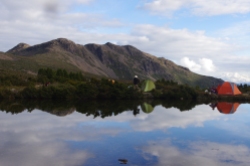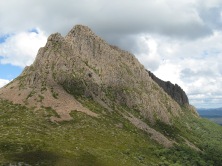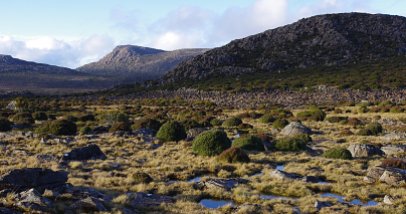It’s a perfect autumn morning in Pretty Valley. The grass and tents are frosted with ice, the air is cold and invigorating, the silence immense. Sitting and waiting for the sunlight to spread across the plains from the hills to the west, it feels so silent you can hear the earth itself humming. In the shallow valley below, white mists form above the marshy landscape and braided waterways, rising until they meet a temperature inversion, which creates a ceiling effect that stops further upward movement. The flat topped mists then flow slowly towards the south east. Finally, the sun starts to warm my back. The air fills with bird call, the parrots sweep through, chitting as they fly past. After a cold night, it seems like everyone and everything is glad to be alive this morning.
On 26 October 2018 the Victorian Government, the Taungurung Land and Waters Council Aboriginal Corporation (TLaWCAC), and the Taungurung Traditional Owner group signed a number of agreements under the Traditional Owner Settlement Act 2010 (Vic), which means that ownership of nine Victorian parks and reserves, including Mt Buffalo National Park and a section of the Alpine National Park, and up to five ‘surplus’ public land parcels have been transferred to the Taungurung Traditional Owner Group.
It should be noted that there is an ongoing territorial dispute between the Taungurung people and clans that identify as Ngurai Illum Wurrung, Waywurru and Dhudhuroa, and has the potential to affect the state’s treaty negotiations. This impacts the agreement in the east of the area, which includes Mt Buffalo and the Alpine national park.
It has now been announced that Gunaikurnai Land and Waters Aboriginal Corporation (GLaWAC) has been ‘re-negotiat(ing) the Gunaikurnai Recognition Settlement Agreement with the State of Victoria’, and ‘we’re excited by the addition of four new joint managed parks as part of our Early Outcomes package’.
Continue reading “Gunaikurnai to jointly manage Baw Baw, Alpine and other high country parks”
Tali Karng is a magical lake, tucked away in the mountains north east of Licola in the Victorian high country.
According to Parks Victoria, Tali Karng is the only natural lake within the Victorian Alps. ‘Held behind a rock barrier created thousands of years ago, the underground stream it feeds emerges as the infant Wellington River 150m below in the Valley of Destruction’. It is about 14 ha in size and sits in a deep valley. It has been a hugely popular walking destination for decades, especially with scout and school groups, and ‘doing the Tali Karng’ walk is a rite of passage for many as they transition from weekend to longer walking trips. It is also a place that reflects the changing way we view, manage and visit our wild natural places.
The lake is on the traditional lands of the Gunaikurnai people, most likely members of the Brayakaulung clan. When I first visited Tali Karng at 15 years of age, I had no idea of the First Nation connection and we often camped by the lake. There was no signage or acknowledgement of the traditional owners. At that point I had no awareness of Aboriginal people in the mountains and I assume that was the same for most people who loved bushwalking.
That started to change after the Gunaikurnai won a Native Title determination in 2010.
Continue reading “Tali Karng – a jewel in a changing landscape”
Mountain Journal has published a number of stories in recent years about the fact that Jaithmathang Original Country elders are returning to the mountains to reconnect with their Yerto (meaning land/country high up).
As Jaithmathang Senior Elder, Loreman and Songman, Goengalla Jumma Myermyal Minjeke said in 2021, “in 1830 there was a population of more than 600 Jaithmathang Original People living in our isolated pristine Yerto Alpines, in our Mountain Ranges and on our fertile High Plains Country”.
“By the early 1850s our population was decimated and there were only a handful of our people left; there was the arrival and occupation by pastoralists and miners, and then the numerous massacres and killings. The last few Jaithmathang who were left were removed away from our Country to other surrounding settlements”.
Now reconnection is happening. This story comes from Karina Miotto and Goengallayin Jumma Jumma.
Continue reading “‘A brief story of a remarkable Historical gathering’”
In 2018 the Victorian Government, the Taungurung Land and Waters Council Aboriginal Corporation (TLaWCAC), and the Taungurung Traditional Owner group signed a suite of agreements under the Traditional Owner Settlement Act 2010 (Vic), and related legislation.
The Recognition and Settlement Agreement has now come into effect. This means that ownership of nine Victorian parks and reserves, include Mt Buffalo National Park and a section of the Alpine National Park, and up to five surplus public land parcels have been transferred to the Taungurung Traditional Owner Group.
While members of other Aboriginal groups have also claimed native title in areas covered by the agreement and said they had been excluded from the agreement, Taungurung are currently increasing their involvement in a number of aspects of land management within the parks, including Buffalo national park.
Representatives of the Ngurai Illum Wurrung, Waywurru and Dhudhuroa people were among respondents who applied for a judicial review of the agreement process (details on that case available here).
The text below comes from North East Catchment Management Authority (CMA) and details recent activity on the Buffalo Plateau (original release available here).
Continue reading “‘Working together to protect Taungurung country’”
The film Where The Water Starts aims to reveal how the fragile alpine region of the Snowy Mountains, particularly Kosciuszko National Park, is seen by a number of Indigenous and non-Indigenous people who were born or live in the southern mountains area, or who care deeply about it.
The launch of this important film will happen on Thursday October 28th at 6.30pm followed by Q&A with
- Richard Swain, Indigenous Ambassador with the Invasive Species Council,
- Professor David Watson, Environmental Scientist, and
- the filmmakers, Mandy King & Fabio Cavadini
Threats to the Snowy Mountains continue: Amendments to the Kosciuszko National Park Plan of Management have been published for public feedback, which set out the ‘desired changes’ to the area over the next 40 years (the submission timeline has now closed).
If approved, the plan would see a huge amount of development, including several thousand extra beds in resorts and new areas, occurring within this precious and fragile alpine park.
Meanwhile, Snowy Hydro pushes ahead with its plan to excavate approximately seven million cubic metres of earth for the project’s tunnels and subterranean power station.
That spoil will then be dumped on 55 hectares across four sites within Kosciuszko National Park.
Now a Traditional Owner representing the Ngarigo Nation in southern New South Wales says she has received no consultation about a plan to dump tonnes of waste spoil on her Country.
Continue reading “Traditional owners concerned with plan to dump spoil in Kosciuszko National Park”
Jaithmathang Original Country elders are returning to the mountains to reconnect with their Yerto (meaning land/country high up). This story was produced by North East Catchment Management Authority and reproduced with their permission.
Jaithmathang Senior Elder, Loreman and Songman, Goengalla Jumma Myermyal Minjeke looks out over Yerto (meaning land/country high up) while standing on Mt Loch and reflects on a separation from Jaithmathang Original Country that has lasted generations. Mt Loch is within Shared Yerto of the GunaiKurnai and Jaithmathang Original Peoples’ Country.
Continue reading “Jaithmathang Senior Elders reconnect with their original Country”An Indigenous Land Use Agreement (ILUA) between Taungurung Land and Waters Council and the State Government is in ‘legal limbo’ after the Federal Court found it was registered incorrectly.
The land use agreement was finalised in October 2018 as part of a broader settlement agreement largely under the auspices Victoria’s Traditional Owner Settlement Act 2010. The settlement agreement formally recognised the Taungurung people as the traditional owners of more than 20,000 square kilometres of land in north central Victoria from Kyneton in the west to Bright in the east. The agreement includes a number of national parks, including sections of the Alpine National Park and Buffalo National Park.
Federal Court proceedings concluded earlier this month, with Justice Debra Mortimer finding errors in the way the agreement was registered with the National Native Title Tribunal.
It is not yet clear whether this will impact on the agreements regarding the Alpine national parks.
Continue reading “Taungurung Indigenous Land Use Agreement in ‘Limbo’”
Jida Gulpilil is a proud Dhudhuroa man and in coming months will be sharing his stories of the mountains, valleys and rivers that make up his mother’s Country of the Dhudhuroa in the north east Victorian Alps.
Jida says:
‘These sites are incredibly important to our people and need to be protected and our stories shared. Therefore, we encourage you to come a walk with us to grow a greater understanding and respect of our sites and places, culture and language, customs and ceremonies that all connect us to our totems and biodiversity.
‘Give yourself the opportunity to truly understand this natural and cultural landscape from our perspective that will help to protect our waterways and landscapes for many more generations.
Continue reading “Dhudhuroa stories of the mountains, valleys and rivers”On 26 October 2018 the Victorian Government, the Taungurung Land and Waters Council Aboriginal Corporation (TLaWCAC), and the Taungurung Traditional Owner group signed a suite of agreements under the Traditional Owner Settlement Act 2010 (Vic), and related legislation. The agreement was signed after a 15-year campaign by traditional owners and three years of settlement negotiations.
The Recognition and Settlement Agreement has now come into effect. This means that ownership of nine Victorian parks and reserves, include Mt Buffalo National Park and a section of the Alpine National Park, and up to five surplus public land parcels have been transferred to the Taungurung Traditional Owner Group.
Continue reading “Taungurung people to jointly manage Buffalo and part of Alpine National Park”
I am keenly aware that no Aboriginal group or nation ever ceded it’s land to the colonisers. So those of us living in Australia are all living on stolen land. There is a lot of unfinished business that needs to be resolved, starting with negotiating a meaningful treaty between First Nations and the rest of the people living on this continent.
For a long time, indigenous people and traditions were white washed out of mainstream narratives about the mountains. As traditional owner groups reassert their connection to Country, that is slowly changing, and we can see it across the Alps. The first Aboriginal person I knew who had a strong connection to the mountains was Eddie Kneebone, who I met through our campaign work in north east Victoria in the 1990s. He had an astonishing depth of knowledge. He was instrumental in the campaign to have the Niggerheads on the Bogong High Plains renamed. It got me thinking about the power of language and names.
Continue reading “Traditional names for ‘Australian’ mountains”


































































Recent Comments